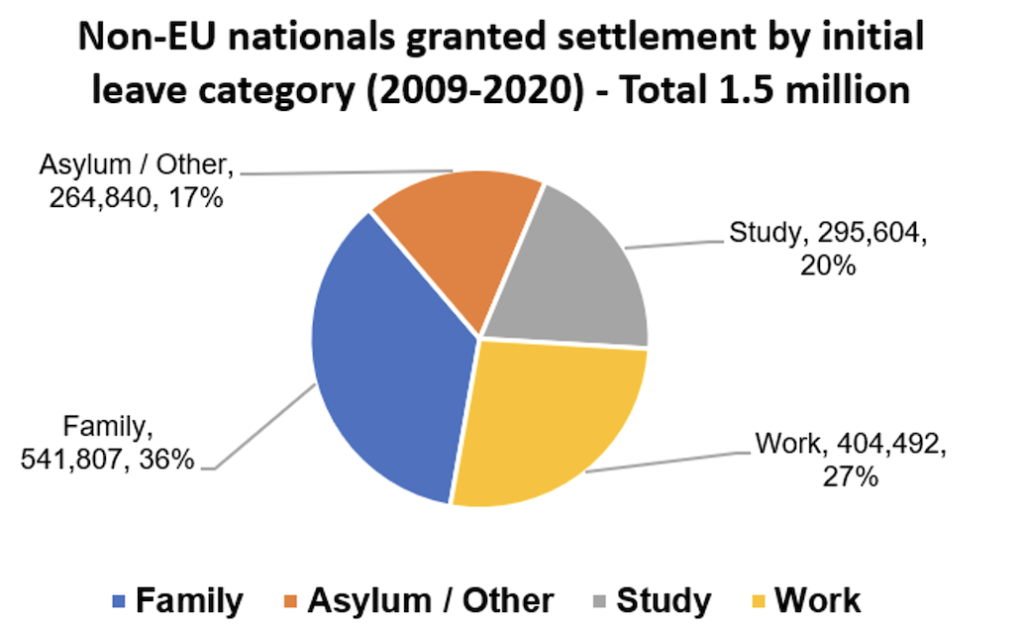
Summary
Our analysis below looks at the original pathways into the UK for the 1.5 million non-EU migrants who have permanently settled in the UK since 2009. It finds, in parallel with the Migration Advisory Committee, that the route allowing the immigration of the relatives of people who are already in the UK has been the largest non-EU route leading to permanent residency.
It also finds that nearly 300,000 non-EU people who originally entered the UK on a study visa were granted permanent settlement. This even after countless unfounded claims by immigration activists that barely any non-UK students remain here after their studies are complete. These Home Office statistics show that claim to be a lie.
Main detail
An average of just over 100,000 people have been granted settlement in the UK each year since 2011. Since 2009, about 1.5 million people have been granted settlement.
What have been the most significant routes of entry for non-EU who choose to remain permanently?
Statistics regarding the routes by which people entered are not available for EU citizens (as they would have largely come under free movement rules until 2021. However, non-EU citizens have come via visa routes so such information is available with respect to them (covering the period 2009-20) – see the chart below illustrating a summary of the Home Office’s migrant journey statistics.
Figure 1: Migrants granted settlement by the category of leave to remain they were initially granted in the UK. Home Office, migrant journey statistics, 2021.

The migrant journey data on settling non-EU citizens’ visa routes depicted below accords with the finding by the government’s official expert Migration Advisory Committee that the family stream has been the largest non-EU route leading to permanent residency.[i]
Those who entered on a family visa or permit (including EEA family permit) accounted for more than a third of people granted settlement between 2009 and 2020. Of those granted settlement in 2019 who initially entered on a family visa, top nationalities were Pakistani (16%) and Indian (10%).
Nearly 300,000 migrants who originally entered on a study visa were also granted settlement in that period. As immigration for study is meant to be a temporary route (with no direct path to settlement), most of these migrants will have switched into another route enabling settlement or applied to remain under the ten-year long-term residency rule. Of all those granted settlement in 2019 who had initially entered on a Study visa, the most common nationalities were Indian (21%), Pakistani (12%) and Chinese (10%).
Meanwhile, of nationalities granted Tier 2 (work) visas in 2014, citizens of Pakistan accounted for the highest proportion granted settlement after five years (47%).
Separately it should be noted that there have been five-six million grants of settled or pre-settled status for EU citizens and their family members under the EU settlement scheme since it opened in 2019.
What happened in 2021?
There were 107,976 decisions on applications for settlement in the UK in 2021, 24% more than in 2020, and 14% more than in 2019. Of these, 106,192 (98%) were granted.
As the Home Office explains, ‘in the latest year, there were increases in settlement grants in the work, family and other categories but fewer to applicants who had been asylum seekers’.
There was an increase in grants of settlement for family reasons, to 37,133, up 78% since 2020, and 44% more than in 2019. Grants had previously fallen from a peak of 75,852 in the year ending March 2010 to 4,939 in the year ending September 2017.
There were also increases for:
- Settlement by skilled (formerly Tier 2) workers, which increased by 27% since 2020 to 21,605, though this is still a reduction of 6% when compared to 2019.
- Those previously in the UK for other reasons, primarily long residence or discretionary leave, rose 65% in 2020 to 14,620, a similar level to 2019 (15,653). This follows a sharp fall prior to the onset of the pandemic.
There was a decrease in settlement granted for asylum-related reasons, down 19% from 2020 to 25,262, a similar level to 2018 (25,787). This reverses the increase seen for those individuals granted refugee status in the UK around the time of the 2015/16 ‘migration crisis’, when larger numbers of asylum seekers claimed in the UK (and in Europe in greater numbers), becoming eligible for settlement. Nonetheless, the asylum category accounted for nearly a quarter (24%) of settlement grants in 2021. There were increases in the asylum and family categories and decreases in the work and other categories when compared with 2019′.
